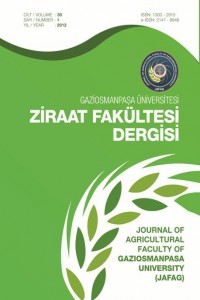Abstract
Heterosiklik aminler (HA) kırmızı et, kanatlı eti ve balıkların yüksek sıcaklıklarda pişirilmesi sonucu oluşan mutajenik/kanserojenik bileşiklerdir. Yüksek sıcaklıkta pişirilen bu et türleriyle yapılan çalışmalarda 20’den fazla farklı HA tespit edilerek tanımlanmıştır. HAler kreatin/kreatinin, aminoasit ve polisakkarit gibi öncül maddelerin Maillard reaksiyonu ve Strecker degradasyon ürünleridir. HA’lerin oluşumu üzerine fiziksel ve kimyasal birçok faktör etki etmektedir. Nitekim, birçok araştırmacı tarafından doğal ve yapay antioksidanlar ve baharat-bitki ekstraktları kullanımı yanı sıra kaplama ve marinasyon uygulamalarının HA oluşumunu önleme/azaltmada etkili olduğu rapor edilmiştir. Bunun yanı sıra etlerde HA oluşumunu önleme/azaltmak amacıyla mangal, ızgara ve kızartma gibi yöntemler yerine haşlama, buğulama ve mikrodalga yöntemleri ile pişirme uygulamaları önerilmektedir. Bu derlemede et ve et ürünlerinde oluşan HA ve oluşumuna etki eden faktörler verilmiştir.
References
- Aaslyng MD, Duedahl-Olesen L, Jensen K and Meinert L (2013). Content of heterocyclic amines and polycyclic aromatic hydrocarbons in pork, beef and chicken barbecued at home by Danish consumers. Meat Science, 93: 85-91.
- Bang J, Nukayab H and Skog K (2002). Blue Chitin columns for the extraction of heterocyclic amines from cooked meat, Journal of Chromatography A, 977: 97–105.
- Borgen E, Solyakov A and Skog K (2001). Effects of precursor composition and water on the formation of heterocyclic amines in meat model systems. Food Chemistry, 74: 11-19
- Calero A, Ayala J, Gonzalez V and Afonso M (2007). Determination of less polar heterocyclic amines in meat extracts Fast sample preparation method using solid-phase microextraction prior to highperformance liquid chromatography-fluorescence quantification. Analytica Chimica Acta, 582: 259– 26
- Damašius J, Venskutonis PR, Ferrance R and Fogliano V (2011). Assessment of the influence of some spice extracts on the formation of heterocyclic amines in meat. Food Chemistry, 126: 149-156. 31 Skog K, Johansson M and Jae Gerstad M (1998). Carcinogenic Heterocyclic Amines in Model Systems and Cooked Foods: A Review on Formation, Occurrence and Intake. Food and Chemical Toxicology, 36: 879-896.
- Skog K, Solyakov A and Jagerstad M (2000). Effects of heating conditions and additives on the formation of heterocyclic amines with reference to aminocarbolines in a meat juice model system. Food Chemistry, 68: 299-308.
- Toribio F, Busquets R, Puignou L and Galceran M (2007). Heterocyclic amines in griddled beef steak analysed using a single extract clean-up procedure. Food and Chemical Toxicology, 45: 667-675.
- Tran NL, Salmon CP, Knize MG and Colvin ME (2002). Experimental and simulation studies of heat flow and heterocyclic amin mutagen/carcinogen formation in pan-fried meat patties. Food and Chemical Toxicology, 40: 673-684.
- Turesky R (2007). Formation and biochemistry of carcinogenic heterocyclic aromatic amines in cooked meats, Toxicology Letters, 168: 219–227.
- Vitaglione P and Fogliano V (2004). Use of antioxidants to minimize the human health risk associated to mutagenic/carcinogenic heterocyclic amines in food. J. of Chrom. B., 802: 189-199. 32
Abstract
Heterocyclic amines (HA) are the mutagenic/carcinogenic compounds which generate as a result of cooking of red meat, poultry meat and fish fillets at high temperatures. Up to 20 different HAs were detected and classified in the researches that conducted on these types of meats cooked at high temperatures. HAs are the products of Maillard reactions and the Strecker degredation of main precursors such as creatine/creatinine, aminoacid and the polysaccharides. Many physical and chemical factors effect the formation of HAs. Thus, it was reported by many researchers that utilizing coating and marination processes in addition to using natural and synthetic antioxidants and seasonings-plant extracts were effective on inhibiting/decreasing the formation of HAs. Additionally, boiling/steaming and microwave cooking methodologies were recommended instead of barbecuing, grilling or frying to inhibit/decrease the formation of HAs. The HAs formed in meat and meat products and the factors which have effects on the formation of HAs are presented in this review.
References
- Aaslyng MD, Duedahl-Olesen L, Jensen K and Meinert L (2013). Content of heterocyclic amines and polycyclic aromatic hydrocarbons in pork, beef and chicken barbecued at home by Danish consumers. Meat Science, 93: 85-91.
- Bang J, Nukayab H and Skog K (2002). Blue Chitin columns for the extraction of heterocyclic amines from cooked meat, Journal of Chromatography A, 977: 97–105.
- Borgen E, Solyakov A and Skog K (2001). Effects of precursor composition and water on the formation of heterocyclic amines in meat model systems. Food Chemistry, 74: 11-19
- Calero A, Ayala J, Gonzalez V and Afonso M (2007). Determination of less polar heterocyclic amines in meat extracts Fast sample preparation method using solid-phase microextraction prior to highperformance liquid chromatography-fluorescence quantification. Analytica Chimica Acta, 582: 259– 26
- Damašius J, Venskutonis PR, Ferrance R and Fogliano V (2011). Assessment of the influence of some spice extracts on the formation of heterocyclic amines in meat. Food Chemistry, 126: 149-156. 31 Skog K, Johansson M and Jae Gerstad M (1998). Carcinogenic Heterocyclic Amines in Model Systems and Cooked Foods: A Review on Formation, Occurrence and Intake. Food and Chemical Toxicology, 36: 879-896.
- Skog K, Solyakov A and Jagerstad M (2000). Effects of heating conditions and additives on the formation of heterocyclic amines with reference to aminocarbolines in a meat juice model system. Food Chemistry, 68: 299-308.
- Toribio F, Busquets R, Puignou L and Galceran M (2007). Heterocyclic amines in griddled beef steak analysed using a single extract clean-up procedure. Food and Chemical Toxicology, 45: 667-675.
- Tran NL, Salmon CP, Knize MG and Colvin ME (2002). Experimental and simulation studies of heat flow and heterocyclic amin mutagen/carcinogen formation in pan-fried meat patties. Food and Chemical Toxicology, 40: 673-684.
- Turesky R (2007). Formation and biochemistry of carcinogenic heterocyclic aromatic amines in cooked meats, Toxicology Letters, 168: 219–227.
- Vitaglione P and Fogliano V (2004). Use of antioxidants to minimize the human health risk associated to mutagenic/carcinogenic heterocyclic amines in food. J. of Chrom. B., 802: 189-199. 32
Details
| Primary Language | Turkish |
|---|---|
| Journal Section | Research Articles |
| Authors | |
| Publication Date | June 1, 2013 |
| Published in Issue | Year 2013 Volume: 2013 Issue: 1 |


